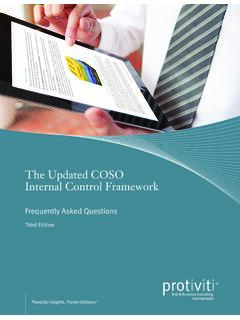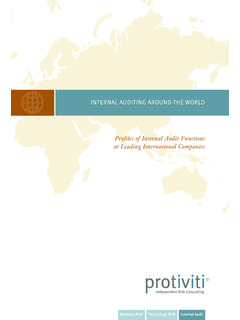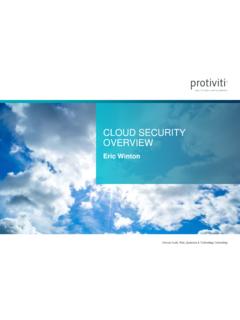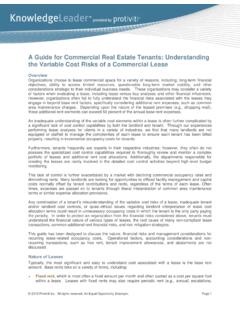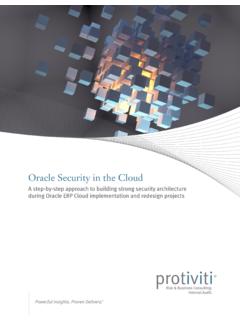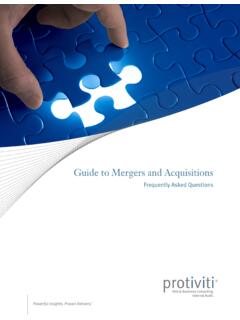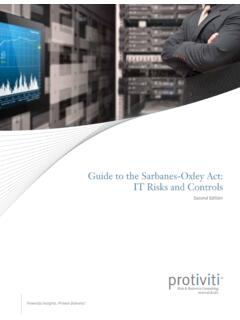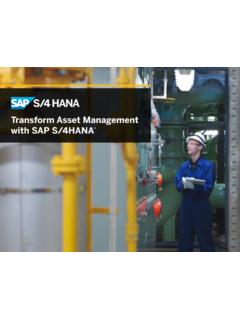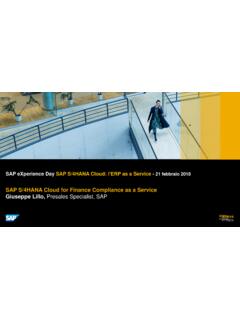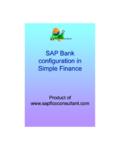Transcription of Enabling Finance Process Digitalization With SAP …
1 Internal Audit, Risk, Business & Technology ConsultingEnabling Finance Process Digitalization with SAP Central FinancePaving the Road for Centralized Financial Reporting and S/4 HANA TransitionEnabling Finance Process Digitalization with SAP Central Finance S/4 HANA innovations hold significant promise for businesses seeking transformation through digital technologies such as massive data processing in real-time, cloud computing and network power, artificial intelligence, communication bots, machine learning and virtual reality to maintain a competitive advantage in a digital economy. SAP Central Finance is one such innovation. It is designed to enable highly automated accounting processes and deliver centralized reporting solutions by bringing disparate accounting systems into one centralized and fragmented accounting systems arise from the coexistence of various SAP releases and non-SAP systems within the same organization typically, as a result of transformative events, such as acquisitions, mergers, spin-offs or organic growth to adapt to changes in the economic environment.
2 Such multiple systems often lead to labor-intensive and manual reconciliations and reporting, and delays in the financial close Process . They also represent a significant obstacle to Finance Process Digitalization , as well as future mergers or acquisitions. SAP Central Finance provides a non-disruptive solution to resolve this problem by acting as a hub into which new entities can be integrated without imposing fundamental changes to the main accounting system. It further helps in the transition strategy to S/4 HANA due to its powerful components designed to harmonize data across various SAP and non-SAP systems, including: A solid master data management Process at the enterprise level Simplified reporting and analytics (single source of truth)
3 Fewer reconciliations and an optimized month-end closing Process A standardized and automated Process to integrate new acquisitions and shorten the post-merger transition periodExecutive Summary2 ProtivitiExcluding SAP Central Finance from an organization s SAP S/4 HANA transition strategy must be carefully considered, as it would preclude an opportunity to build a hub for the insertion of new entities into the core accounting system smoothly, efficiently and cost-effectively in the future and could delay or frustrate Digitalization efforts. To mitigate this risk, and regardless of their stage of transition to SAP S/4 HANA, all multi-entity organizations should assess and compare carefully the benefits of a centralized financial reporting solution based on SAP Central Finance versus the option of excluding it from the transition strategy.
4 This paper provides an overview of SAP Central Finance , its architecture and key functionality, various deployment scenarios, and other key considerations, including the role of business leaders in its is a host of reasons for the existence of different accounting systems within the same organization but the two major ones are: 1. Creation of new entities as part of organic growth or the acquisition of new companies; and 2. Upgrading a part of the existing accounting system to a new technology, essentially creating a system within a system. In either situation, most organizations are aware of the need to define a central accounting system that provides a coherent, comprehensive and centralized view of financial information and reports.
5 Awareness aside, reality shows that most organiza-tions fall short in their efforts to define a centralizedaccounting system using their existing processes and technologies, and as a result suffer from: Tedious and inefficient financial period-end close Complicated and time-consuming reconciliations Manual eliminations of redundant intercompany transactions during the consolidation Process Error-prone adjustments in spreadsheets Lack of an authoritative source of truth with regard to financial information Lack of visibility into historical details of intercompany transactions Time-consuming multi-currency conversions and accountingDefinition of SAP TermsSAP HANA (High Performance Analytic Appliance)
6 Is an in-memory platform for processing high volumes of data in real S/4 HANA is the business suite designed to run processes in the context of a digital Central Finance is both a deployment strategy of SAP S/4 HANA and a product to build a centralized financial reporting and information hub that inserts disparate accounting systems into the core accounting system of the S/4 HANA Finance is a subset of SAP S/4 HANA with a focus on financial and accounting solutions, including financial planning, accounting, financial close, treasury and Finance Causes Fragmented Accounting Systems? Enabling Finance Process Digitalization with SAP Central Finance Does SAP Central Finance Work?
7 Is SAP Central Finance the Answer?More and more organizations are turning to SAP Central Finance , part of SAP s most recent platform, SAP S/4 HANA, to solve the issues inherent in disparate and fragmented accounting systems. In a broad perspective, SAP S/4 HANA is designed with digital technologies in mind, with the purpose of creating highly automated business processes. Applying digital technologies to enterprise processes is also known as business Process Digitalization , and is a necessity for maintaining competitive advantage in a digital economy. Three key characteristics distinguish a digital solution from a traditional one: Mobility combined with constant connection to central resources Vast networks of intelligence that are at the same time flexible enough to create personalized information Real-time streaming combined with on-demand distribution of various forms of data, including big data, massive structured data used in enterprise Finance processes, images, neuronal hierarchies, Central Finance , as a component of SAP S/4 HANA, enables the automation and Digitalization of centralized financial reporting processes and helps support.
8 Central entity reporting Central Process execution Real-time financial close Real-time integration with consolidation, planning and analytical solutions, such as SAP Integrated Business Planning and Business Objects Leveraging SAP reporting tools, such as Fiori, to visualize and analyze the centralized financial data that are sourced from disparate accounting systems Simplifying and streamlining general accounting data that can be used by non-SAP financial management solutionsThe architectural design of SAP Central Finance is based on data replication at the application level rather than the database layer, which is used by traditional data transfer technologies.
9 The application-level data replication is executed in real time and at line-item level with embedded data harmonization functions. These functions enable faster reporting, given the elimination of redundant data, and increase the extent and depth of real-time analysis of financial addition, SAP authorization architecture is applied automatically, providing auditability and security to the SAP Central Finance data and system. This architectural aspect makes the reports coming out of SAP Central Finance reliable and secure even though the data is sourced from non-SAP accounting organizations use home-grown data warehouses or off-the-shelf systems to centralize financial reporting and information.
10 Such solutions have rigid designs that provide limited functions because of challenges related to custom interfaces of non-SAP sources, replication of data in an environment outside of the core SAP technology, data transfers on an aggregated level, and complicated data validation and reconciliation. SAP Central Finance can replace 4 ProtivitiFigure 1. Components of SAP S/4 HANA and SAP Central FinanceMERGERS & ACQUISTIONSPERMANENT SIDECARP rovides a Finance hub for enterprisewide analytics and central processesSupports the strategy to transition to the cloudCreates a platform for accelerated onboarding with early insightsCreates a platform to onboard smaller entities and subsidiariesHarmonizes and centralizes financial reporting and information across non-SAP ERP or mixed landscapesConsolidates on one instance cross-system SAP capabilities like credit, intercompany, treasury.

